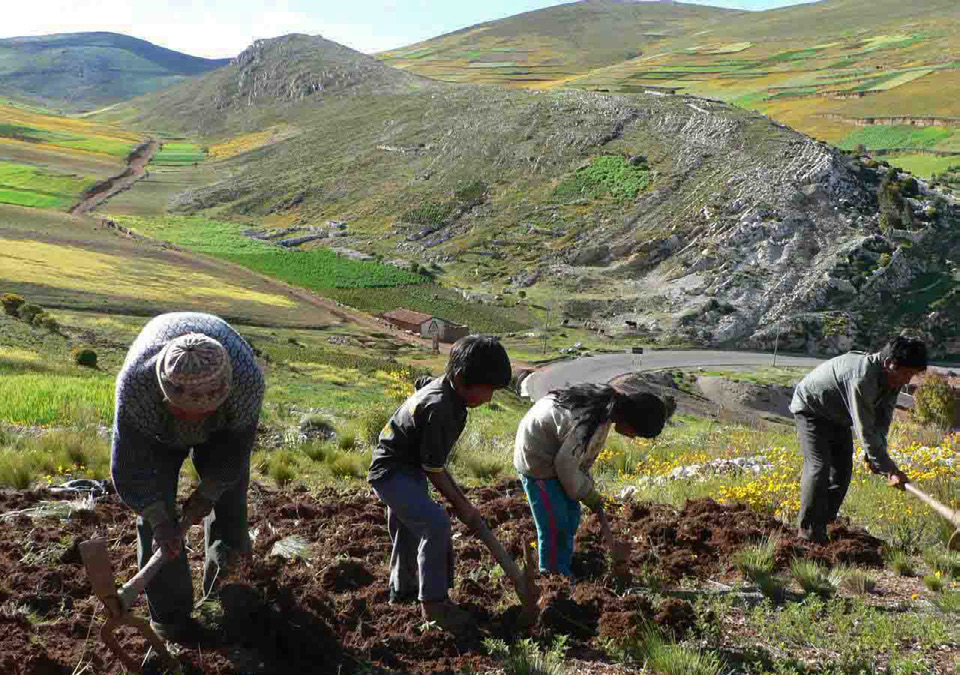THE SOLUTION TO CLIMATE CHANGE IS IN OUR LANDS
A global effort to give small farmers and indigenous communities control over lands is the best hope we have to deal with climate change and feed the world’s growing population.
La Vía Campesina | GRAIN | 05 December 2014
As governments converge on Lima for the UN Climate Change Conference, the brutal killing1 of Peruvian indigenous activist Edwin Chota and three other Ashaninka men this past September is shining a spotlight2 on the connection3 between deforestation and indigenous land rights. The simple truth is plain to see: the most effective and just way to prevent deforestation and its impacts on the climate is to recognise and respect the sovereignty of indigenous peoples’ over their territories.
Peru’s violent land conflicts4 also bring into focus another issue of equal importance to climate change that can no longer be ignored: the concentration of farmland in the hands of a few.
Small farms of less than 5 hectares represent 78% of all farms in Peru, but occupy a mere 6% of the country’s agricultural lands. This disturbing figure mirrors the
global situation.5 Worldwide, small farms account for 90% of all farms yet occupy less than a quarter of the agricultural land. This is bad news for the climate.
Just as the dispossession of indigenous peoples of their territories has opened the door to destructive, unsustainable resource extraction, the dispossession of
peasants of their lands has laid the basis for an industrial food system that, amongst its many negative effects, is responsible for 44-57% of all global greenhouse gas
emissions.6
Food does not have to make such an overweight contribution to climate change. GRAIN estimates that a worldwide redistribution of lands to small farmers and
indigenous communities, combined with policies to support local markets and cut the use of chemicals, can reduce global greenhouse gas emissions by half7 within
a few decades and significantly curb deforestation. Simply by rebuilding the organic matter that has been depleted by decades of industrial agriculture, small
farmers can put a quarter of the excess carbon dioxide8 that is now in the atmosphere back into the soil.
Giving lands back to small farmers and indigenous communities is also the most effective way to deal with the challenges of feeding a growing global population
in an era of climate chaos. The available global data show that small farmers are more efficient9 at producing food than big plantations. On the fraction of lands
that they have held on to, small farmers and indigenous communities continue to produce most of the world’s food10 – 80% of the food in developing countries says
the FAO. Even in Brazil, a powerhouse of industrial agriculture, small farms occupy a quarter of the farmlands but produce 87% of the country’s cassava, 69% of its
beans, 59% of its pork, 58% of its cow milk, 50% of its chickens, 46% of its maize, 33.8% of its rice and 30% of its cattle.11
The twin needs of feeding the world and cooling the planet can be met. But not if the governments meeting in Lima continue to ignore and violently repress the struggles
of their peasants and indigenous peoples for land.
1. Andrew C Revkin, “Can Peru Control the Murderous Resource Rush on its Forest Frontiers?”, New York Times, 10 October 2014.
2. Jonathan Watts, “Spotlight on murders of activists as Peru prepares for Lima climate talks”, Guardian, 17 November 2014.
3. Ann Clark Espuelas, “On Eve of Climate Talks in Lima, Assassinations of Indigenous Leaders Loom Large”, Huffington Post, 19 November 2014.
4. Global Witness, “Peru’s Deadly Environment”, November 2014.
5. GRAIN, “Hungry for land: small farmers feed the world with less than a quarter of all farmland”, May 2014.
6. Rani Molla, “How Much of World’s Greenhouse-Gas Emissions Come From Agriculture?”, Wall Street Journal, 29 September 2014.
7. GRAIN, “Food and climate change: the forgotten link”, September 2011.
8. Ibid.
9. GRAIN, ”Hungry for land”.
10. Ibid.
11. Ibid.
Credit to Henk Hobbelink:
Henk is an agronomist by training. In the 1980s he worked with farmers in Peru on sustainable pest management and after that he worked with Dutch and European NGOs drawing attention to the importance of agricultural biodiversity for the future of farming. In 1990, he co-founded GRAIN and over the past two decades has helped the organisation grow into an international collective that works to support small farmers and social movements in their struggles for community-controlled and biodiversity-based food systems. Henk is the coordinator of GRAIN, and as such is responsible for the overall functioning of the organisation as well as conducting research, writing and outreach activities.





No comments yet